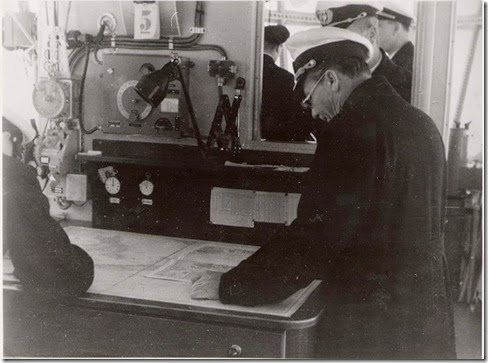LVI
The passengers rarely, or never, saw
the crew areas of the Hindenburg.
 |
|
The R.M.S. Mauretania of 1907 was the world's largest steamship for a time,
and the world's fastest for over 20 years, but her top speed of less than 30
mph was poky compared to the Hindenburg's
85 mph. Both ships were of equivalent length and overall size
|

Unlike the Graf Zeppelin, Hindenburg's
passenger decks and flight decks were in separate areas of the ship. Although
passengers could ask for tours of the bridge, the navigation room, and other
areas, the habit was not encouraged on the newer airship.
Flight operations were confined to the
gondola. The gondola was divided into three areas, the control room (bridge), the
navigation or chart room, and a small general purpose room toward the stern.
 |
|
A
cutaway diagram of the Hindenburg’s
bridge
|
 |
|
The
gondola of the Hindenburg, with its
nose wheel. The rear lower stabilizer also had a wheel
|
The radio room and weather station sat
directly above the gondola within the hull, and were accessible via a fixed
stairway in the general purpose room.
 |
|
The radio room and weather station lay
above the gondola and inside the hull. The Hindenburg had the most modern
communications equipment in the world, most provided by Deutsche Telefunken
|
 |
|
Captain
Ernst Lehmann in the Chart Room
|
 |
|
The mail
room of the Hindenburg
|
Crew accommodations were also within
the hull, specifically within the keel, which also contained the mail room,
luggage and cargo areas and mechanical rooms. With typical German efficiency,
spaces were organized by duties: The riggers and technicians had dormitory
cabins spaced along the keel, while the officers' space was near the gondola
(the captain had a small private cabin in the same vicinity). The engineers and
motormen had dormitory cabins located near the engine gondolas. The stewards'
cabins were adjacent to "A" Deck, the larger of the two passenger
decks.
Crew space in the Hindenburg was small, cramped, and unheated, but was relatively
palatial compared to that on the Graf
Zeppelin and other airships. The Chief Steward (who was also the Head of
Passenger Services for the airline) even had a small passenger-type cabin and
office space to himself on "B" deck.
 |
|
A crewman's bunk on the Hindenburg. Note the wine bottles
|
 |
|
Emilie
Imhof, the world’s first Stewardess
|
When Emile Imhof, the world's first
female Flight Attendant (Stewardess) was hired in the midst of the 1936 season,
Ms. Imhof was primly given cabin space on "B" Deck as well, away from
the rough-hewn conditions in the hull proper.
No comments:
Post a Comment